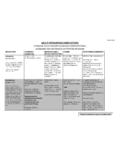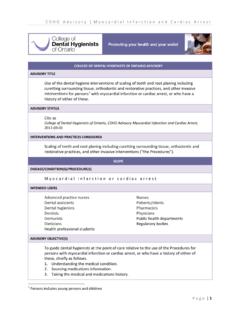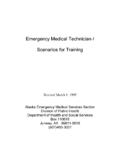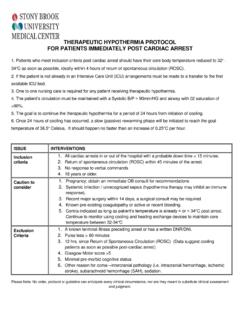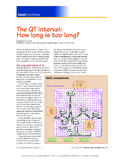Transcription of Medical Office 911: Expecting the Unexpected
1 Consider this scenario: A 68-year-old woman presented to her family Physician for her yearly physical exam. The woman approached the registration desk and advised she was not feeling well. Just prior to reaching the counter she collapsed. Although there was a defibrillator in the Office and equipment for intubation, there was no crash cart with emergency drugs. The Physician immediately instructed the secretary to call 911. No emergency care was administered while awaiting EMS arrival other than the Physician placing the patient in the recovery position on the floor to diminish the chance of fluid aspiration. Despite aggressive resuscitation efforts by paramedics, the patient was pronounced dead shortly after arrival at the hospital. The subsequent lawsuit alleged that had the Physician used any of the modalities available to him and had the appropriate equipment been available, the patient would have there are no statutory provisions that outline the requirements for responding to Medical emergencies in the Office setting, patients expect that a Medical practice will be equipped and prepared to respond to potentially life-threatening Medical emergencies should they occur.
2 As the above scenario illustrates, failure of Physicians and staff members to respond appropriately to these kinds of situations may lead to a Medical malpractice Office 911: Expecting the UnexpectedContinued on next pageSuzanne StoneVolume 19 No. 2 Winter 2011 Dear Colleague:When a Medical emergency occurs in the private Office setting, it usually strikes without warning, affording the practice precious little time to issue of Doctors RX discusses the importance of establishing a plan of action to address Unexpected Medical emergencies and provides information to consider when evaluating your practice s emergency S. Malouf, Jr., of the BoardMedical Mutual Liability Insurance Society of Maryland Professionals Advocate Insurance CompanyAlthough not an everyday occurrence, Medical emergencies in private Medical offices do occur, possibly more often than expected.
3 A study of rural general practitioners demonstrated a median of eight emergencies per year, with 95 percent seeing at least one emergency in the past Emergencies are more common in primary care pediatric offices. One survey of 52 pediatric offices showed a median of 24 emergencies per year, with 82 percent of the offices reporting an average of at least one emergency per In another study, 62 percent of pediatricians and family Physicians practicing in an urban setting reported assessing more than one patient per week who required emergency care or The most common types of emergencies in primary care offices include asthma complications, psychiatric-related issues, seizures, anaphylaxis and cardiac In pediatric offices, common emergencies are respiratory-related problems, seizures, infections in infants and If you are a specialist, you are likely already prepared for an emergency that is within your scope of practice.
4 However, you should consider whether you are ready to handle emergencies outside your scope, such as a patient who is having an anaphylactic reaction to latex gloves. Emergency PreparednessDespite the fact that patient emergencies happen infrequently, even one can be too many if you are not adequately prepared. Emergency Office preparedness begins with an evaluation of various aspects of your Office and practice. This includes consideration of the following questions:1. What types of emergencies have occurred in your Office in the past year, and how often have you encountered such emergencies over the course of your Medical career? 2. What type of patients do you treat? Do you treat a substantial number of patients who have special health needs or co-morbidities outside of your specialty?
5 If so, what are the most common poten-tial emergencies these patients might experience? 3. Is your Office freestanding, or is it located in a large health center, a clinic or a hospital? 4. How far is your Office from an emergency department or other emergent care facility? 5. How long does it take emergency services to re-spond to a 911 call from your Office ? Some articles indicate that average response times can be 11 to 16 minutes. If you are located in a rural area, the response time could be answers to these questions can be the first step in evaluating your Office s response to a Medical emergency and developing a plan for when a Medical emergency occurs in your Office . When developing an emergency response plan consider the items discussed below. Specialty Specific Emergency Guidelines While there are no official regulations for adult emergencies, check with your specialty society to see if they have minimum recommendations for emergency medications and equipment.
6 For example, The American Academy of Pediatrics has issued guidelines to assist offices in establishing an emergency plan. The guidelines include a list of recommended supplies and are available at: ;120/1 , Medical emergencies are not something that most offices will experience on a regular basis. However, should the Unexpected occur, having an emergency response plan in place and ensuring that staff is appropriately trained is the best way to reduce the potential for liability exposure and may ultimately save a life. 1. According to a study published in the Ameri-can Family Physician, the most common types of emergencies in primary care offices include asthma complications, psychiatric-related issues, seizures, anaphylaxis and cardiac arrest. A. True B. False 2. A written emergency plan is necessary only if you determine that EMS response time is likely to take longer than 16 minutes and none of the staff are trained in basic life support.
7 A. True B. False 3. All staff should have a copy of the practice s Medical emergency plan, however, there is no added benefit in having front Office personnel participate in mock emergency drills, since generally they are not medically trained. A. True B. False 4. One survey of 52 pediatric offices showed a median of 24 emergencies per year with 82 percent of the offices reporting an average of at least one emergency per month. A. True B. False 5. All Medical offices, even those that do not treat pediatric patients, are required to keep pediatric doses of common drugs such as epinephrine and Benadryl. A. True B. False6. Seizures, dehydration, infections and respira-tory problems are common types of emergencies reported in pediatric settings. A. True B. False 7. When rapid defibrillation is performed in a medically supervised environment, survival rates can be as high as 79 percent.
8 Survival decreases by about 5 percent each minute until a defibrillator is applied to a patient experiencing cardiac arrest. A. True B. False 8. As long as a thorough report of the emergency steps taken to treat the patient is transmitted to emergency service personnel there is no need to document the same information in the patient s Medical record. A. True B. False 9. Basic supplies that should be included in all emergency kits include an intravenous catheter, IV medication and an AED unit. A. True B. False 10. Although there are no specific provisions in the law which outline exactly how Physician offices are required to respond to Medical emergencies, every Office should conduct an analysis of their practice to determine the most appropriate plan for emergency management. A. True B. FalseCME Test QuestionsInstructions for CME ParticipationCME Accreditation Statement Medical MuTuAl liability Insurance Society of Maryland, which is affiliated with Professionals Advocate Insurance company, is accredited by the Accreditation council for continuing Medical Education (AccME) to provide continuing Medical education for Physicians.
9 CME Designation Statement Medical MuTuAl liability Insurance Society of Maryland designates this enduring material for a maximum of one (1) AMA PRA category 1 credits(s).TM Physicians should claim only the credit commensurate with the extent of their participation in the activity. Instructions to receive credit, please follow these steps:1. Read the articles contained in the newsletter and then answer the test Mail or fax your completed answers for grading: Med Lantic Management Services, Inc. Fax: 410-785-2631 225 International circle Box 8016 Hunt Valley, Maryland 21030 Attention: Risk Management Services Dept. 3. One of our goals is to assess the continuing educational needs of our readers so we may enhance the educational effectiveness of the Doctors RX. To achieve this goal, we need your help. You must complete the cME evaluation form to receive credit.
10 4. completion Deadline: March 31, 20125. upon completion of the test and evaluation form, a certificate of credit will be mailed to you. #Creating a Crash Cart Although emergency supplies do not need to be maintained in a traditional crash cart, it is wise to keep all such supplies in one easily accessible location. You can assemble the supplies on your own or purchase a pre-assembled kit. The answers to the above evaluation of your patient population and the types of emergencies you may encounter will guide you in deciding what equipment, supplies and medication to have readily may want to consider purchasing an Automatic External Defibrillator (AED), which is standard equipment for many practices. If your Office regularly treats patients who are at risk for cardiac events, this machine may be the difference between life and death.

